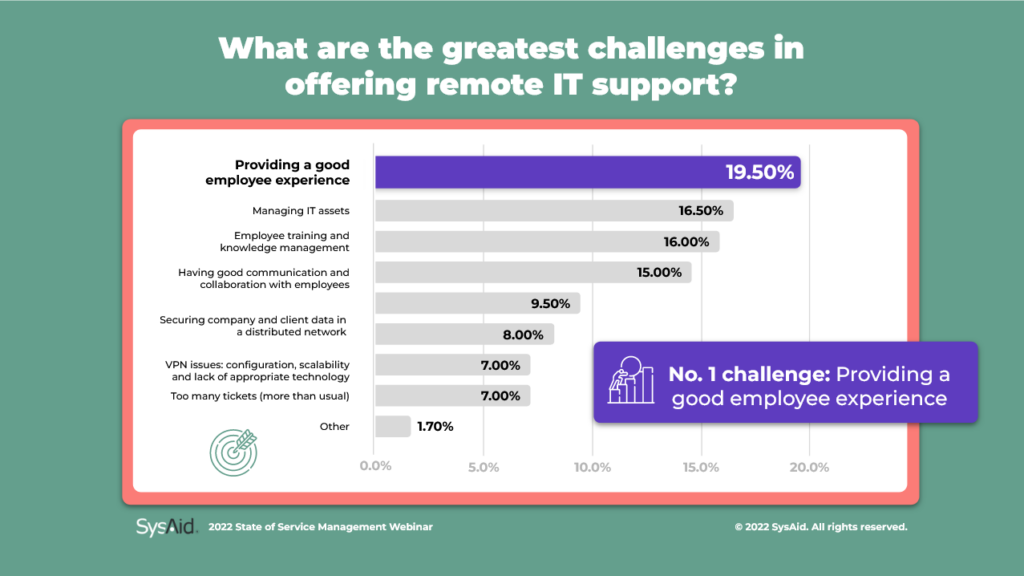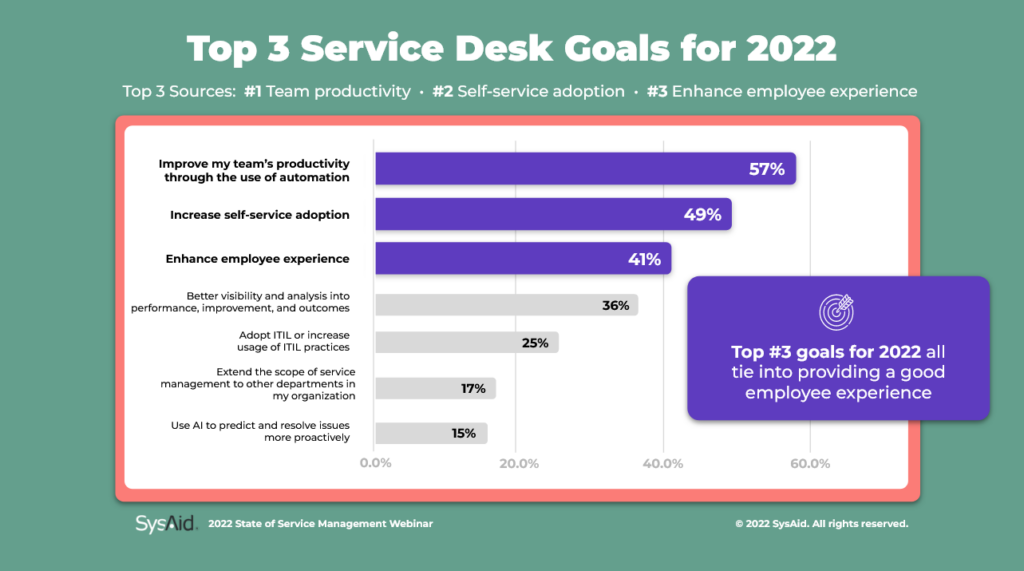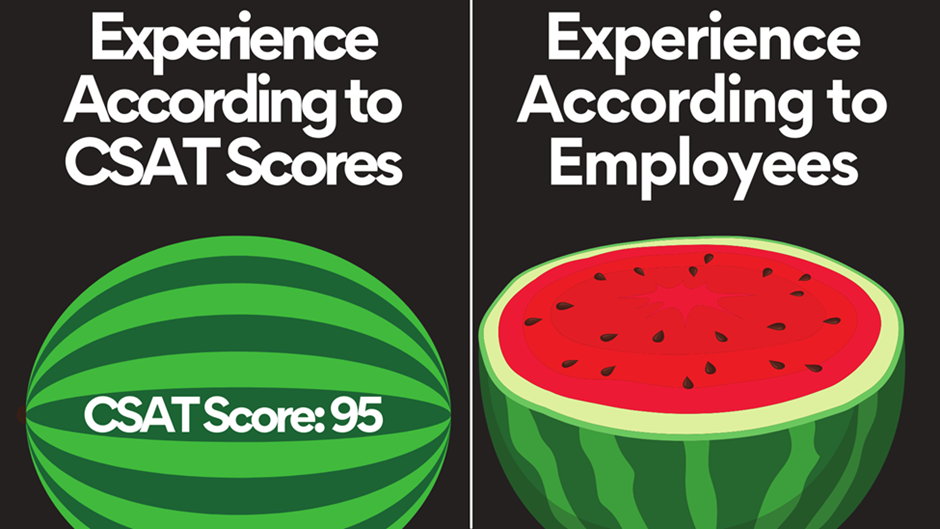How to Measure Employee Experience

Last month I was privileged to get to sit in with the SysAid team and help present the results from their 2022 State of Service Management study. SysAid collected surveys from over 1,200 IT professionals and we revealed the results live to over 800 folks from around the globe on a webinar with Erik Snider and Gaelle Elgazar. Besides being an absolute blast and a fun conversation, the data was eye-opening in several ways, particularly when it comes to the topic of employee experience.
In this blog @Why discusses some of the key data points from @SysAid's 2022 State of Service Management study related to employee experience. #ITSM #EX Share on X
The first eye-opener for me was this graphic showing that providing a good employee experience was identified by IT leaders as the #1 challenge in offering remote support. Don’t get me wrong, I’m not surprised that this is a challenge, but what I loved was that IT leaders across the globe are talking about it, that it’s a priority.
Listen, providing a good experience for remote employees has always been a huge challenge. The fact that IT leaders are now identifying it as such, however, is an amazing indicator that we, as an industry, are still trending in the right direction, even more so after the pandemic, and that the term IT “experience” is likely to move beyond buzzword status and onto the priority lists of IT leaders everywhere.
But let’s not get too excited just yet. Identifying experience as a challenge and solving experience in reality are two different things. A few slides later in the webinar, the following slide caught my eye and provided an awesome contrast to the previous statistic.

Each one of the top three service desk goals for 2022 are awesome. Productivity, self-service adoption, and employee experience are all great priorities. I suppose what struck me during the webinar was this question: why would the number one challenge not be the number one priority?
Providing a good experience for remote employees is named the no1 challenge for IT leaders in @SysAid's latest report YET employee experience is only listed as the 3rd most important #servicedesk goal. How does that stack up asks @Why #ITSM #EX Share on XYou might argue that automation and self-service adoption will anyways result in a better experience for the employees we support, but assumptions like that are dangerous. As a former social scientist with two psychology degrees, I tend to get a little scientific about things like this. Namely, because I’ve worked with so many teams that execute so amazingly, but fail to reach their potential because there were assumptions baked into their strategy that limited the change they had hoped to achieve.
So while employee experience *might* benefit indirectly from increased automation and self-service adoption, it behooves us as leaders to look at the direct results of these top three service desk goals.
- “Improve my team’s productivity through the use of automation.” The direct result is clearly a benefit to your team, not the employee experience of the folks you support. Good employee experience increases when employees are more productive, but not necessarily when IT teams are more productive.
- “Increase self-service adoption.” Again, who does self-service adoption help directly? It helps us, not the employees we support. Particularly when the harmful trend of “forcing” employees to use self-service options is the strategy used. The best way to increase self-service adoption is simple, straightforward, and proven: make the self-service options so awesome that employees get addicted to them and don’t want other methods of support. How do you do that? We’ll get there, don’t worry.
- “Enhance employee experience.” Why is it that employee experience is seen as the number one challenge for supporting remote employees but it’s not one of our #1 goal for 2022? I can’t answer that (that would involve an assumption!), but if I had to guess, it would be one simple, unavoidable fact. Enhancing the employee experience is hard. The funny thing is, however, that when teams focus on employee experience first, then self-service adoption rises on its own, because it’s now a better experience. If you focus on employee experience as your north star metric, you listen more to the employees you support. When you listen, in my experience, you understand what they need and don’t need from you, which frees up time and resources to build automation.
How Do We (Accurately) Measure Experience?
Employee experience has always been something we talk about in IT. However, when you try to go beyond the talk to actually deliver an awesome employee experience, you’re likely to encounter what I did as an IT director at Yahoo, Verizon, and Box. Our industry has dozens of benchmarks and metrics to measure efficiency, up time, systems, and what we do as an IT department. However, it turns out that measuring the effect that what we do has on the employees we support has been something we haven’t quite nailed as an industry.
As a result, we were left with either CSAT or NPS. Sure CSAT is ubiquitous, but does it measure employee experience? Not even close!
Measuring the effect that what we do (in IT) has on the employees we support has been something we haven’t quite nailed as an industry – @Why #servicedesk #ITSM #EX Share on XIn fact, this metric does a poor job of measuring its namesake, customer satisfaction. It claims to measure it, but unfortunately the math, the science (or lack thereof) of modern CSAT scoring simply doesn’t provide an accurate, reliable, or actionable measure of the real employee experience. It’s easy to implement, and it looks good on a graph, but we know from decades of benchmarks that deploying CSAT surveys, in most cases, fails to move the needle on, much less transform the employee experience.

This is where we get the term “watermelon metrics.” CSAT is known as a watermelon metric because on the outside everything looks green, but on the inside, when you talk to actual employees, it’s often bright red. In other words, CSAT might make your experience look good on paper, but IRL, statistically, it doesn’t help move the needle for the real-life experience employees have at work.
NPS, or Net Promoter Score®, mathematically is way better, hence it being adopted in the consumer world. It’s also heavily benchmarked so you can compare your NPS with that of Apple, Google, or just about any fortune 500 company, product, or service. As for being actionable, however, even the inventor of NPS claims looking back, he wished he had made it more actionable.
What I Learned From Creating a New Metric
Faced with these non-ideal choices, and armed with a graduate education in psychology, I brought my years of quantifying human experience to the world of IT metrics. After months of research, I came up with QSTAC®, the first ITXM, or IT Experience Management tool used by ITSM teams. It doesn’t replace ITSM metrics, you’ll always need these. What it does is give you the data that traditional metrics are missing: an accurate, quantifiable employee experience score, with benchmarks to compare and, most importantly, a readout that tells you what to do about your score and how to improve.
Measure. Understand. Improve. Sounds simple, and it is, which is awesome. QSTAC is now an enterprise tool that has gained increased adoption lately, and so as a thank you, what I’d love to do now is pay it forward, if you will, and share my learnings with anyone else that, like me, knows there has to be a better way to measure employee IT experience.
In this blog @Why shares three tips to make sure your experience data actually measures experience #EX Share on XThree tips to make sure your experience data actually measures experience
- Always anonymous. You’ll NEVER know the actual experience employees have with your team until you get anonymous, untraceable, untracked data. Almost every IT team does an after-ticket survey, I’m sure you do too. Has that completely transformed you into the Ritz Carlton of IT Experience Delivery Teams? If so, I’d love to hear about it, you would be the first. However, the research says that if it’s not anonymous, it not only paints an incomplete picture of employee experience, but sometimes the data even misleads teams to the extent that they’re worse off for sending out a survey at all. This might be a hard pill to swallow, but it’s the medicine that will make you better as an IT team, so down the hatch!
- Only ask what you’re prepared to take action on. We’re all busy, so why are many employee engagement surveys ten minutes long with 10, 20, sometimes even 40 questions? The last company I worked at went through four employee engagement platforms in the four years I worked there, and I hear they still change platforms every year. Why? Because the surveys ask so many questions, that any meaningful, actionable data drowns in the superfluous data, and real change never results. The data is so numerous and complex that very little ever gets done. QSTAC®, the ITXM tool I built, takes 30 seconds, not thirty minutes to complete. What we’ve found is that when you only ask what you know you’ll take action on, you save everyone a ton of time, and because you’re thoughtful in what you ask, the results lead to real change. For instance, the average QSTAC customer raised employee experience by 16 NPS points in 2021! Ask less, more actionable questions and watch experience rise. Bonus: our response rate is 25%-50%, so asking only what you’ll act on also gives you even more data, just targeted to what you’ll implement, cutting out the fluff.
- Make Experience Your North Star Metric. If employee experience is one of 20 metrics, it’ll at best get 5% of your attention. But if experience truly is our number one challenge as IT service management (ITSM) teams, shouldn’t we give it more juice? IT professionals are a competitive bunch. If you give them a dashboard of 20 metrics, they’ll try to get them all green. But what if you had one single north star metric. Every team meeting, all hands, and quarterly planning meeting you pull up your IT Experience score. This simple focus on what matters most to the people who matter most is what I attribute the numerous industry awards my teams have won. Believe me, it had little to do with my leadership skills and much more to do with the fact that the team had a single, unified focus: the experience that employees have when using or interacting with IT people and tools.
Measure What Matters
While measuring experience accurately is new, uncharted territory, it’s not optional. 95% of all companies, yours probably included, considers employee experience a top priority for 2022. And since the employee experience is now digital, this is now necessarily an IT priority too. We own employee experience, and you can’t improve what you can’t measure. So take this as an opportunity to measure what matters most to the people who matter most. Your employees will love you for it, and at the end of the day, it makes being in IT a lot more fun.
Did you find this interesting?Share it with others:
Did you find this interesting? Share it with others:









